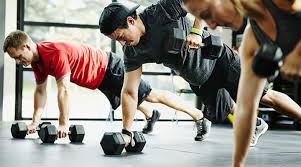In today’s fitness culture, many people associate exercise with appearance—toned muscles, visible abs, or weight loss. But there’s another vital purpose for working out that goes beyond the mirror: functional fitness. This approach emphasizes exercises that improve daily movement, enhance mobility, and build real-life strength. Whether you’re lifting groceries, climbing stairs, or playing with your kids, functional fitness prepares your body to perform everyday tasks with ease and safety.
What Is Functional Fitness?
Functional fitness refers to training your body to handle real-world movements and activities. Rather than isolating muscles through machine-based or aesthetic-focused routines, functional workouts involve multiple joints and muscle groups working together in natural patterns.
These movements mimic activities such as:
- Squatting down to lift something
- Reaching up to place an item on a high shelf
- Twisting to grab something behind you
- Carrying heavy bags
- Pushing a door open
Key Benefits of Functional Fitness
1. Improved Mobility and Flexibility
Functional training encourages a full range of motion, helping joints stay flexible and muscles move freely. This is especially important as we age and naturally lose flexibility.
2. Enhanced Core Strength
Most functional exercises engage the core, improving balance, posture, and overall strength. A strong core reduces the risk of back injuries and supports proper body alignment.
3. Better Balance and Coordination
Since many movements in functional training are multi-directional and dynamic, they challenge your stability. This builds neuromuscular control, which helps prevent falls and improves athletic performance.
4. Injury Prevention
Functional fitness improves muscle balance and joint stability. By mimicking everyday actions, it prepares your body to move more efficiently and safely, reducing the risk of strains or falls.
5. Time Efficiency
Because functional workouts involve compound movements that target multiple muscle groups, they burn more calories and deliver more results in less time compared to isolated exercises.
Examples of Functional Exercises
Here are some common and effective functional fitness movements:
- Squats – Mimic sitting or lifting something from the ground
- Lunges – Improve walking, climbing stairs, and side-to-side movement
- Push-ups – Build upper body and core strength
- Pull-ups or Rows – Develop back muscles used in pulling motions
- Kettlebell Swings – Improve hip strength and explosive power
- Planks – Strengthen the core, shoulders, and back
- Deadlifts – Train your body to lift objects correctly from the ground
Who Can Benefit from Functional Fitness?
The beauty of functional fitness is that it’s adaptable to all fitness levels and ages. Beginners can use bodyweight-only movements, while more advanced individuals can add weights or resistance. Seniors can improve balance and prevent falls, while athletes can enhance performance in sports.
Whether you’re a busy parent, office worker, or retiree, functional fitness can be customized to fit your lifestyle and physical condition.
Functional Fitness vs. Traditional Training
| Functional Training | Traditional Training |
|---|---|
| Focuses on movement patterns | Focuses on individual muscles |
| Mimics real-life activities | Often machine-based or static |
| Improves everyday performance | Improves appearance or strength |
| Core and joint stability focused | May neglect balance or coordination |
| Lower risk of injury | May cause muscle imbalances |
Both styles can have value, but for long-term wellness and real-world strength, functional fitness offers greater day-to-day benefits.
How to Start a Functional Fitness Routine
Step 1: Assess Your Daily Needs
Think about the physical tasks you perform daily. Do you lift, bend, twist, walk long distances, or carry children? Tailor your workouts to mimic those motions.
Step 2: Begin with the Basics
Master bodyweight exercises like squats, lunges, planks, and push-ups. Focus on form and control rather than speed or weight.
Step 3: Add Resistance and Equipment
As you build strength, introduce tools like dumbbells, kettlebells, resistance bands, or stability balls to challenge your muscles and improve coordination.
Step 4: Include Variety
Incorporate exercises that move in different planes: forward, backward, side-to-side, and rotational. This prepares your body for all types of movements.
Step 5: Stay Consistent
Functional fitness is most effective when practiced regularly. Aim for 3–4 sessions per week, and mix strength, mobility, and cardio-based movements.
Tips for Safe and Effective Training
- Warm up properly before every session
- Focus on quality of movement over quantity
- Breathe throughout each movement
- Progress slowly and listen to your body
- Consult a trainer or physical therapist if you’re recovering from injury
Final Thoughts
Functional fitness is not a trend—it’s a return to purposeful, smart movement. In a world that increasingly emphasizes aesthetics, functional training reminds us that being fit means being capable. It empowers you to move better, feel stronger, and live more fully.
Start small. Stay consistent. And soon, you’ll see the real-world strength benefits in every part of your life.

